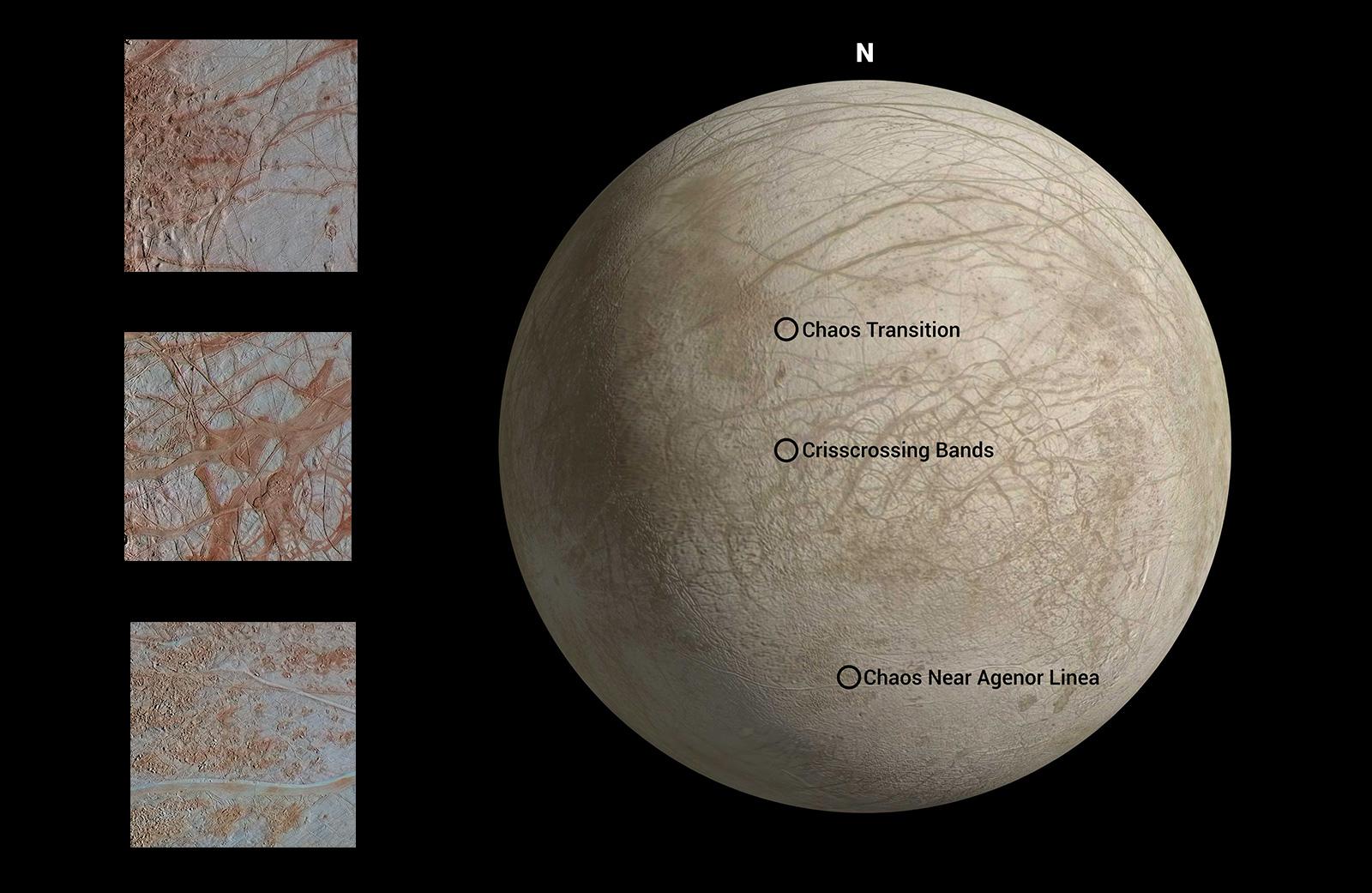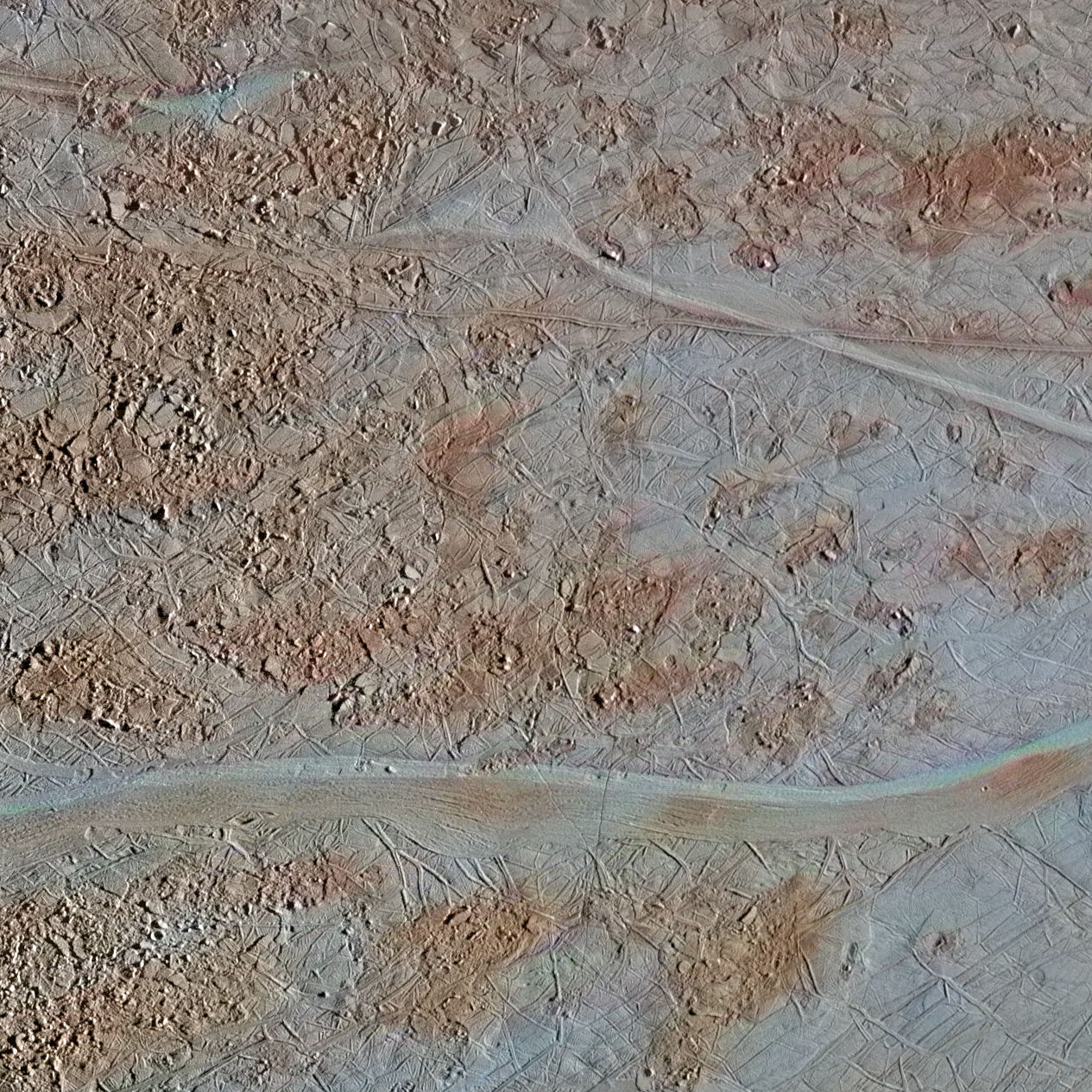Chaos reigns in detailed new views of Jupiter's icy moon Europa

Scientists have gotten their best look to date at three chaotic patches on the icy surface of Jupiter's moon Europa thanks to decade-old images from a long-defunct spacecraft.
NASA's Galileo spacecraft spent eight years touring the Jupiter system, between 1995 and 2003, and during that time it made 11 flybys of the icy moon Europa. On Sept. 26, 1998, during one such maneuver, Galileo captured particularly detailed black-and-white images of the moon's crackled surface. Now, scientists have revisited those images to prepare for future missions to the intriguing world.
"We've only seen a very small part of Europa's surface at this resolution," Cynthia Phillips, a planetary geologist at NASA's Jet Propulsion Laboratory in California and Europa project staff scientist working on future missions, said in a statement. "Europa Clipper will increase that immensely."
Related: Europa, mysterious icy moon of Jupiter in photos
Europa Clipper is a new NASA mission targeted to launch in in 2023 or 2025 and make 45 passes over the moon. During that time, it will study Europa's thin atmosphere, icy surface, hypothesized subsurface ocean and internal magnetic field, giving scientists their first look at the moon since the Galileo mission.
To prepare for the new mission, scientists are trying to squeeze all the information they can out of Galileo's data — and that's where the reprocessed images come in. During the 1998 flyby, Galileo was able to capture images that showed surface features just 1,500 feet (460 meters) wide.

Such detail is important because it turns out there's lots going on at Europa's surface. First of all, it's strangely young, just 40 million to 90 million years old, one of the freshest surfaces in the whole solar system. (The moon, like Earth and the rest of the solar system, is about 4.6 billion years old.)
Get the Space.com Newsletter
Breaking space news, the latest updates on rocket launches, skywatching events and more!
Europa's ice is also very active: it's crisscrossed with wide, flat bands where ice has formed between spreading blocks, ridges hundreds of feet tall where ice repeatedly bangs together and separates, and patches so messy that scientists straight up dubbed their structure "chaos terrain." In these areas, scientists believe that blocks of ice have migrated, popped around and twisted, then been trapped again in ice freezing around them.

That's nifty, but the Galileo images are grayscale shots of the moon's surface. And for Europa, color photographs can tell scientists another important detail about the icy story, particularly when image processing experts emphasize small visible differences in color. Those differences reflect chemical composition: white or blue areas have higher levels of pure water ice, whereas redder areas contain other compounds, like salts, which potentially originated in the moon's hypothesized global ocean.
The new images start from Galileo's high-resolution black-and-white images and add in color from lower-resolution images, offering scientists the best of both worlds.
- NASA unveils most amazing view of Jupiter's moon Europa ever (video)
- Water plumes on Europa: The discovery in images
- Weird mystery of watery plumes on Europa may hint at 'stealth particles'
Email Meghan Bartels at mbartels@space.com or follow her @meghanbartels. Follow us on Twitter @Spacedotcom and on Facebook.
OFFER: Save 45% on 'All About Space' 'How it Works' and 'All About History'!
For a limited time, you can take out a digital subscription to any of our best-selling science magazines for just $2.38 per month, or 45% off the standard price for the first three months.
Join our Space Forums to keep talking space on the latest missions, night sky and more! And if you have a news tip, correction or comment, let us know at: community@space.com.

Meghan is a senior writer at Space.com and has more than five years' experience as a science journalist based in New York City. She joined Space.com in July 2018, with previous writing published in outlets including Newsweek and Audubon. Meghan earned an MA in science journalism from New York University and a BA in classics from Georgetown University, and in her free time she enjoys reading and visiting museums. Follow her on Twitter at @meghanbartels.
-
charlemur Appreciate the overall journalism of space that you do, I have been a silent viewer for awhile but I comment here for a touch of respectful criticism. I usually speak as objectively as possible, but I say this with elements of subjectivity, so forgive me if I seem dramatic.Reply
A lot of your articles break my heart, over and over again. Because of your misleading titles.
I understand "click-bait" and actually appreciate the tool when it is used in a fun way, but you guys use it to mislead the audience into thinking you have some BREAKING SPACE NEWS, but then when times comes to read the article its ALWAYS way way less amazing than your title says.
I reply on this thread for your latest title "Chaos reigns in detailed new views of Jupiters ice moon Europa"
YOU KNEW, that people that follow new findings about space have had their eyes on Europa because of its theoretical sub-surface ocean, a potential for other forms of life, a thing that is REALLY COOL. you grabbed that idea and said "Hey I wonder how to kick a guy in their hearts <<Removed by moderator>>?" success my friend. You make it seem there are new photographs of Europa making everyone click on your damn sadness of an article,
like the aunty that says something vague but amazing and you ask her "Is that really true wow!" and then to clarify she does a fart akin to a babies sneeze. You know what you're doing and its so regurgitating you have slowly made me tired of science and space making it seem like nothing is actually happening out there. (My own drive and happiness is my reason-ability I know)
Your kind of titles are used alongside Youtubers that say "GOT A CALL FROM THE REAL SANTA AT MIDNIGHT "
Again, love those titles they are hilarious and stupid and everyone knows the content is NEVER what is said in the title.
But for <<Edited by moderator>> sake you are a news outlet for SCIENCE and SPACE, meant to be giving us the new breaking news on the latest discovers of science and space but a lot of the time your titles are always "too good to be true" and that is heart breaking to me.
OTHER TITLES YOU COULD HAVE USED THAT DOESN'T HURT ME BUT WILL STILL MAKE ME CLICK:
- EUROPA: Scientists unearth data for next mission
- New ideas from old data about EUROPA.
- EUROPA's older data tells us newer information for next mission
Sorry if this was upsetting to you, refer back to my first paragraph and don't read the rest. -
Geomartian You are calling our prize-winning ice garden on Europa chaotic?Reply
Cultural heathens.
Kang and Kodos










